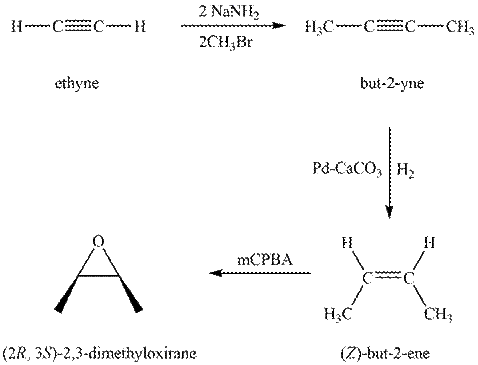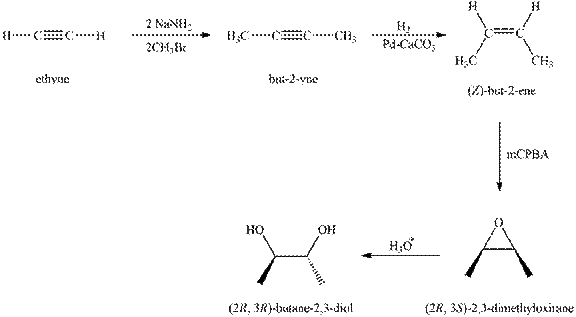
Concept explainers
Devise a synthesis of each compound from acetylene and any other required reagents.
a.  b.
b.  c.
c.  d.
d.
(a)
Interpretation: Synthesis of the given compound from acetylene and other required reagents is to be devised.
Concept introduction: Terminal alkynes can be converted into internal alkynes by forming new
In presence of sodium metal in ammonia, the is alkyne is reduced to
Answer to Problem 12.63P
Synthesis of the given compound from acetylene and other required reagents is shown in Figure 1.
Explanation of Solution
Synthesis of the given compound is shown below.

Figure 1
In the first step acetylene is converted to
In the final step,
Synthesis of the given compound from acetylene and other required reagents is shown in Figure 1.
(b)
Interpretation: Synthesis of the given compound from acetylene and other required reagents is to be devised.
Concept introduction: Terminal alkynes can be converted into internal alkynes by forming new
The addition of
Answer to Problem 12.63P
Synthesis of the given compound from acetylene and other required reagents is shown in Figure 2.
Explanation of Solution
Synthesis of the given compound is shown below.

Figure 2
In the first step acetylene is converted to
In the final step,
Synthesis of the given compound from acetylene and other required reagents is shown in Figure 2.
(c)
Interpretation: Synthesis of the given compound from acetylene and other required reagents is to be devised.
Concept introduction: Terminal alkynes can be converted into internal alkynes by forming new
The addition of
In presence of peroxide alkene is oxidized to epoxide this is known as epoxidation. The weak pi bond of alkene and weak
Answer to Problem 12.63P
Synthesis of the given compound from acetylene and other required reagents is shown in Figure 3.
Explanation of Solution
Synthesis of the given compound is shown below.

Figure 3
In the first step, acetylene is converted to
Synthesis of the given compound from acetylene and other required reagents is shown in Figure 3.
(d)
Interpretation: Synthesis of the given compound from acetylene and other required reagents is to be devised.
Concept introduction: Terminal alkynes can be converted into internal alkynes by forming new
The addition of
In presence of peroxide alkene is oxidized to epoxide this is known as epoxidation. The weak pi bond of alkene and weak
Answer to Problem 12.63P
Synthesis of the given compound from acetylene and other required reagents is shown in Figure 4.
Explanation of Solution
Synthesis of the given compound is shown below.

Figure 4
In the first step acetylene is converted to
Synthesis of the given compound from acetylene and other required reagents is shown in Figure 4.
Want to see more full solutions like this?
Chapter 12 Solutions
Organic Chemistry
Additional Science Textbook Solutions
Chemistry
Fundamentals of Heat and Mass Transfer
Chemistry: Structure and Properties
Organic Chemistry
Organic Chemistry
Chemistry & Chemical Reactivity
- Devise a synthesis of each compound from benzene.arrow_forwardDevise a synthesis of each compound from benzene, any organic alcohols having four or fewer carbons, and any required reagents.arrow_forwardDevise a synthesis of each compound from cyclohexene and any required organic or inorganic reagents.arrow_forward
- Devise a synthesis of each compound from phenol (C6H5OH) and any other organic or inorganic reagents.arrow_forwardDevise a synthesis of attached compound from benzene, any organic alcohols having four or fewer carbons, and any required reagentsarrow_forwardDevise a synthesis of each compound from cyclohexene and any required organic compounds or inorganic reagents.arrow_forward
- Devise a synthesis of each compound from benzene. You may use any other organic or in organic reagents.arrow_forwardDevise a synthesis of each compound from cyclohexene and anyrequired organic compounds or inorganic reagentsarrow_forwardDevise a synthesis of each compound from an alkyl halide using any other organic or inorganic reagents.arrow_forward
- Draw a stepwise mechanism for the following reduction.arrow_forwardDevise a synthesis of attached compound from an alkyl halide using anyother organic or inorganic reagents.arrow_forwardDraw a stepwise mechanism for the following reaction that forms ether D. D can be converted to the antidepressant uoxetine (trade name Prozac) in a single step.arrow_forward
 ChemistryChemistryISBN:9781305957404Author:Steven S. Zumdahl, Susan A. Zumdahl, Donald J. DeCostePublisher:Cengage Learning
ChemistryChemistryISBN:9781305957404Author:Steven S. Zumdahl, Susan A. Zumdahl, Donald J. DeCostePublisher:Cengage Learning ChemistryChemistryISBN:9781259911156Author:Raymond Chang Dr., Jason Overby ProfessorPublisher:McGraw-Hill Education
ChemistryChemistryISBN:9781259911156Author:Raymond Chang Dr., Jason Overby ProfessorPublisher:McGraw-Hill Education Principles of Instrumental AnalysisChemistryISBN:9781305577213Author:Douglas A. Skoog, F. James Holler, Stanley R. CrouchPublisher:Cengage Learning
Principles of Instrumental AnalysisChemistryISBN:9781305577213Author:Douglas A. Skoog, F. James Holler, Stanley R. CrouchPublisher:Cengage Learning Organic ChemistryChemistryISBN:9780078021558Author:Janice Gorzynski Smith Dr.Publisher:McGraw-Hill Education
Organic ChemistryChemistryISBN:9780078021558Author:Janice Gorzynski Smith Dr.Publisher:McGraw-Hill Education Chemistry: Principles and ReactionsChemistryISBN:9781305079373Author:William L. Masterton, Cecile N. HurleyPublisher:Cengage Learning
Chemistry: Principles and ReactionsChemistryISBN:9781305079373Author:William L. Masterton, Cecile N. HurleyPublisher:Cengage Learning Elementary Principles of Chemical Processes, Bind...ChemistryISBN:9781118431221Author:Richard M. Felder, Ronald W. Rousseau, Lisa G. BullardPublisher:WILEY
Elementary Principles of Chemical Processes, Bind...ChemistryISBN:9781118431221Author:Richard M. Felder, Ronald W. Rousseau, Lisa G. BullardPublisher:WILEY





